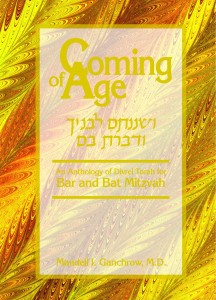Coming of Age: An Anthology of Divrei Torah for Bar and Bat Mitzvah
 Coming of Age: An Anthology of Divrei Torah for Bar and Bat Mitzvah
Coming of Age: An Anthology of Divrei Torah for Bar and Bat Mitzvah
Edited by Mandell I. Ganchrow, M.D.
OU Press
New York, 2012
280 pages
Reviewed by David Olivestone
If you are asked to speak at a family or a friend’s simchah, you probably won’t have too much trouble coming up with some fine accolades and an amusing anecdote or two to relate about the newly-married couple, or the new parents or the newly-adult boy or girl (please select the appropriate category).
But unless you are an experienced community rav whose mind is constantly on the prowl for material to use at a simchah, finding a d’var Torah that both neatly fits the occasion and ties into the parashat hashavua may be a lot harder.
Enter Dr. Mendy Ganchrow, balabos extraordinaire, whose many decades as a community leader—including six years as president of the Orthodox Union—have made him the friend or acquaintance of a huge roster of leading rabbis and scholars. At his invitation, nearly one hundred of them have contributed essays to Coming of Age, Dr. Ganchrow’s final volume in his “simchah trilogy” (following Sason VeSimcha for sheva berachot and Entering the Covenant for a brit milah).
In the style of the previous volumes, Coming of Age includes brief messages addressed to the bar/bat mitzvah based on ideas contained in every parashah of the year as well as all the Jewish holidays. Needless to say, the messages are very apropos to the occasion, always uplifting and often positively inspiring. Pity the poor rabbi to whom one of the more difficult parshiyot was assigned, and who really had to stretch to make a connection to the celebration at hand. But of course it’s just these parshiyot where you and I would also have the most trouble finding something appropriate to say, and so we are even more grateful to Dr. Ganchrow for supplying us with Torah content for every single parashah.
Almost all of the essays, even those that mention only a bar mitzvah boy, could just as easily apply to a bat mitzvah girl. However, a most insightful piece, by veteran educator Susan Dworken Koss, deftly brings the bat mitzvah celebration into focus. This is one of a number of diverse pieces found in a special section at the end of the book that stand outside of the timeframe of the parshiyot and holidays. It also includes one very necessary essay addressed to children who are deaf.
Chazal impress upon us that we may not quote the sayings or ideas of another without giving attribution to the author. Whoever incorporates any of these divrei Torah when speaking at a simchah—whether a sheva berachot, a brit milah or now a bar or bat mitzvah celebration—should feel proud to thank not only the author, but also Dr. Ganchrow, who conceived of the idea of collecting them for us and carried it out in so splendid a manner.
David Olivestone is senior communications officer at the Orthodox Union.
